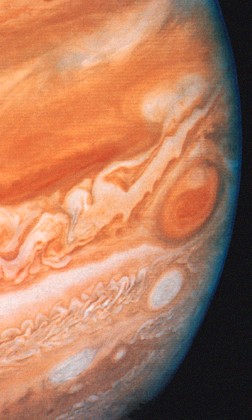 Back Back |
Next
|
Terrestrial/Jovian
Division Not an Accident
-
All planets have a rocky
core
-
Planets close to the Sun
are warmer
| Planet |
K |
oC |
oF |
| Mercury |
600 |
327 |
621 |
| Mars |
300 |
27 |
81 |
| Jupiter |
150 |
-123 |
-189 |
| Neptune |
63 |
-210 |
-346 |
-
Hot atoms and molecules move
faster than cold ones (phases of matter)
-
solids--molecules/atoms locked
in
-
liquids--molecules/atoms
loosely associated
-
gas--each molecule/atom independent
-
plasma--atoms knocking the
electrons out of each other
-
Gas molecules/atoms are acted
upon by gravity
-
Heavy gasses like CO2
(carbon dioxide) or CH4 (methane) can stick to small planets/moons
-
Light gasses like H2
(hydrogen) and He (helium) escape
-
Light gasses stick to Jovian
planets
-
Atmosphere composition
influenced by temperature, gravity
-
Example: water
-
Water on Mercury boils--gas
(water vapor)
-
Most water on Earth is liquid
(oceans)
-
Water in the Jovian planets/moons
is ice
Textbook
Figures 7-7 and 7-8: Jupiter and Mars


 Back Back |
Next
|

